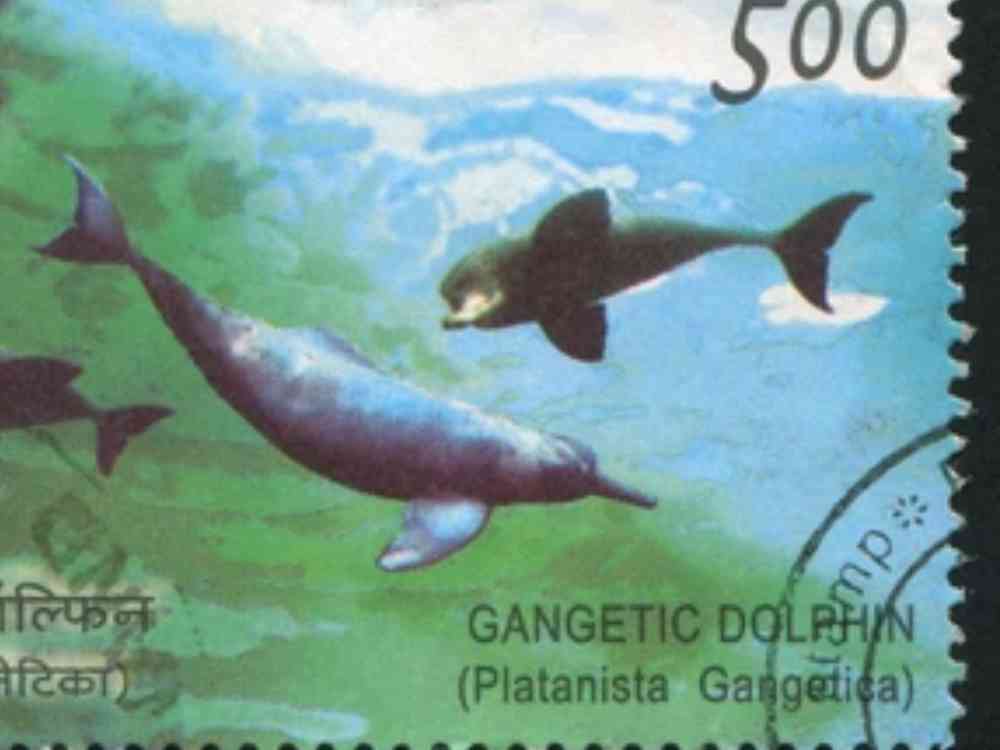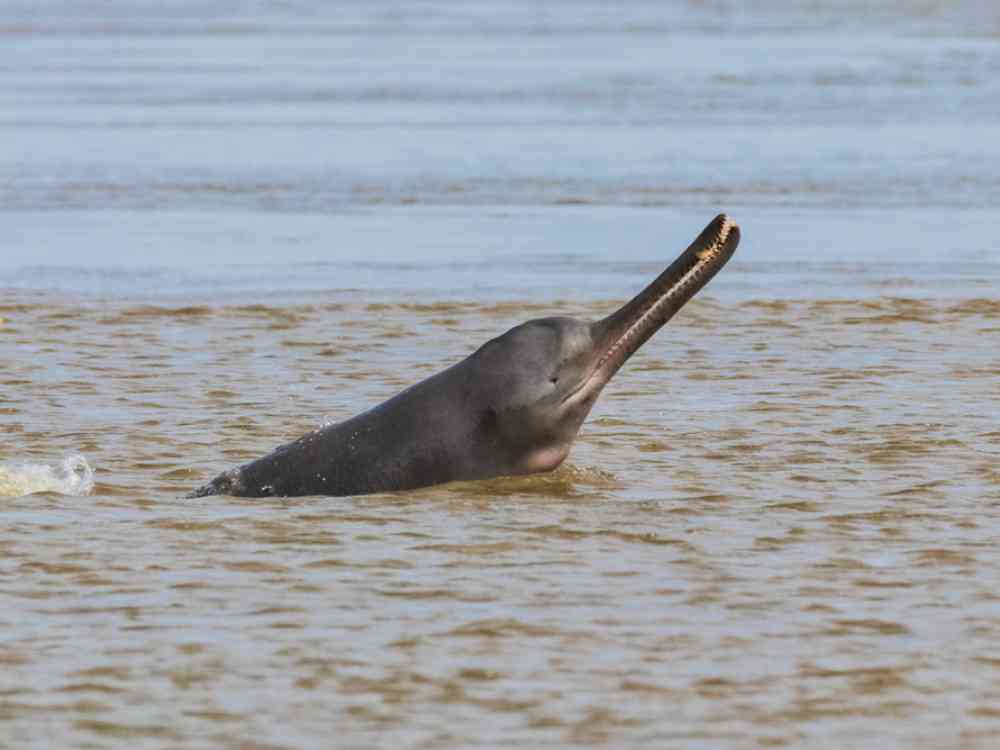After about thirty years, the Gangetic dolphins have experienced a remarkable resurgence in the vicinity of Patna. These at-risk aquatic creatures also referred to as “Susu,” have currently formed a lasting presence along six ghats spanning a 99 km section of the Ganga River. More than 70 dolphins have been observed this year, indicating the river’s environmental well-being and effective preservation endeavors.
The Gangetic River dolphin, which is India’s national aquatic animal, is one of only four species of freshwater dolphins found worldwide. These dolphins are easily recognizable by their long snouts, round bodies, and unique swimming methods, making them a fascinating sight for observers. Researchers and nature enthusiasts are intrigued by these dolphins’ use of ultrasonic waves to navigate and hunt in the murky river waters.
Dolphin Conservation

The focus on protecting the environment through various initiatives is important. The creation of the National Dolphin Research Centre (NDRC) in Patna has played a crucial role in the success of conservation efforts. Launched on March 4, 2024, the NDRC assists researchers in examining dolphin behavior, threats to their survival, and causes of death. Additionally, it educates fishermen on practices that are conducive to dolphin conservation, thus decreasing unintentional harm to these marine animals.
The rise in dolphin sightings serves as proof of the dedication of environmental activists, scientists, and nearby residents. These actions underscore the significance of protecting wildlife habitats and upholding a healthy river ecosystem. The reappearance of Gangetic dolphins in Patna is a notable environmental achievement, highlighting the ecological health of the Ganga River and the effectiveness of conservation initiatives. It also underscores the ongoing necessity of preservation. Safeguarding their habitats is crucial for guaranteeing the existence of Gangetic dolphins for upcoming generations. This impressive resurgence is not only a success story but also a motivator for taking measures to protect endangered species and the rivers where they reside.
Impact on Travel and Tourism

The resurgence of Gangetic dolphins is predicted to positively influence the local tourism sector. With the dolphins attracting attention from international travelers and nature lovers, Patna is poised to emerge as a leading eco-tourism hotspot. The increasing focus on preserving wildlife and river environments corresponds with a larger worldwide movement in which travelers prefer destinations that combine natural splendor with a dedication to eco-friendly tourism. The existence of endangered dolphins in the Ganga River in Patna offers a unique opportunity for travelers to see conservation efforts in action.
The presence of these dolphins could stimulate the local economy by generating employment in eco-tourism, hospitality, and research sectors. As the number of dolphin sightings grows, there may be a rise in guided tours, boat trips, and educational initiatives to attract environmentally-conscious tourists, ultimately raising Patna’s profile in the global tourism industry. The recovery of these dolphins offers a distinctive chance for educational trips. Educational institutions and environmental groups might be attracted to Patna’s efforts in protecting freshwater dolphins, resulting in an increase in individuals interested in environmental conservation, including researchers, learners, and volunteers.
Famous Ghats to see Dolphins

In Patna, there are multiple ghats known for their abundance of these beautiful creatures. Some of the top spots include:
- Gai Ghat: Gai Ghat is a popular location that has become a favorite among visitors and researchers alike. It provides a clear view of dolphins swimming and is considered one of the most reliable places for sightings.
- Triveni Ghat (Fatuha): Located at the meeting point of the Ganga and Punpun rivers, Triveni Ghat is another hotspot for dolphin sightings. More than 20 dolphins have been seen within a one-kilometer radius, highlighting it as a thriving habitat for these marine mammals.
- Rani Ghat: Rani Ghat in Sultanganj is becoming well-known for the frequent sightings of dolphins. Approximately 10 dolphins are a common sight in this location, enhancing the variety of environments in which they can be found thriving.
Five Interesting Facts About Ganges Dolphins

Freshwater Habitat
Ganges dolphins are one of the few species of dolphins that inhabit freshwater environments. They are primarily found in the river systems of the Ganges, Brahmaputra, and Meghna in India, Nepal, and Bangladesh. Their preference for freshwater limits their distribution and makes them particularly vulnerable to environmental changes and human activities.
Echolocation Abilities
These dolphins are essentially blind due to their small eyes and the murky waters they inhabit. Instead of relying on sight, Ganges dolphins use echolocation to navigate and hunt for prey. They emit ultrasonic sounds that bounce off objects, allowing them to “see” their surroundings through sound waves. This adaptation is crucial for locating fish and other food sources in dark or muddy waters.
Endangered Status
The Ganges dolphin is classified as endangered by the International Union for Conservation of Nature (IUCN). Their population has drastically declined from tens of thousands in the past to an estimated 1,200 to 1,800 individuals today. Major threats include habitat degradation due to dam construction, pollution, and accidental capture in fishing nets (bycatch).
Unique Physical Characteristics
Ganges dolphins have a distinctive appearance with a stocky body, a long beak that thickens at the tip, and large flippers that aid in swimming. They can weigh between 150 to 170 kg and reach lengths of up to 2.7 meters. Their skin color varies from light grey-brown at birth to a paler shade as they mature.
Cultural Significance
Recognized as the national aquatic animal of India since 2009, Ganges dolphins play an important role in local ecosystems as indicators of river health. Their presence reflects the overall condition of freshwater habitats, making them significant not only ecologically but also culturally for communities that depend on these rivers.
These fascinating creatures embody both the beauty and fragility of river ecosystems in South Asia, highlighting the urgent need for conservation efforts to protect them and their habitats.
Customize your Patna journey HERE…







